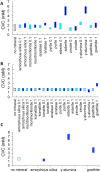Mineral Surface Chemistry and Nanoparticle-aggregation Control Membrane Self-Assembly
- PMID: 28266537
- PMCID: PMC5339912
- DOI: 10.1038/srep43418
Mineral Surface Chemistry and Nanoparticle-aggregation Control Membrane Self-Assembly
Abstract
The self-assembly of lipid bilayer membranes to enclose functional biomolecules, thus defining a "protocell," was a seminal moment in the emergence of life on Earth and likely occurred at the micro-environment of the mineral-water interface. Mineral-lipid interactions are also relevant in biomedical, industrial and technological processes. Yet, no structure-activity relationships (SARs) have been identified to predict lipid self-assembly at mineral surfaces. Here we examined the influence of minerals on the self-assembly and survival of vesicles composed of single chain amphiphiles as model protocell membranes. The apparent critical vesicle concentration (CVC) increased in the presence of positively-charged nanoparticulate minerals at high loadings (mg/mL) suggesting unfavorable membrane self-assembly in such situations. Above the CVC, initial vesicle formation rates were faster in the presence of minerals. Rates were correlated with the mineral's isoelectric point (IEP) and reactive surface area. The IEP depends on the crystal structure, chemical composition and surface hydration. Thus, membrane self-assembly showed rational dependence on fundamental mineral properties. Once formed, membrane permeability (integrity) was unaffected by minerals. Suggesting that, protocells could have survived on rock surfaces. These SARs may help predict the formation and survival of protocell membranes on early Earth and other rocky planets, and amphiphile-mineral interactions in diverse other phenomena.
Conflict of interest statement
The authors declare no competing financial interests.
Figures




Similar articles
-
Mineral-Lipid Interactions in the Origins of Life.Trends Biochem Sci. 2019 Apr;44(4):331-341. doi: 10.1016/j.tibs.2018.11.009. Epub 2018 Dec 21. Trends Biochem Sci. 2019. PMID: 30583961 Review.
-
A Fusion-Growth Protocell Model Based on Vesicle Interactions with Pyrite Particles.Molecules. 2024 Jun 4;29(11):2664. doi: 10.3390/molecules29112664. Molecules. 2024. PMID: 38893538 Free PMC article.
-
Mineral surface directed membrane assembly.Orig Life Evol Biosph. 2007 Feb;37(1):67-82. doi: 10.1007/s11084-006-9018-5. Epub 2006 Aug 15. Orig Life Evol Biosph. 2007. PMID: 16909329
-
Evolution of ribozymes in the presence of a mineral surface.RNA. 2016 Dec;22(12):1893-1901. doi: 10.1261/rna.057703.116. Epub 2016 Oct 28. RNA. 2016. PMID: 27793980 Free PMC article.
-
Primordial membranes: more than simple container boundaries.Curr Opin Chem Biol. 2017 Oct;40:78-86. doi: 10.1016/j.cbpa.2017.07.009. Epub 2017 Aug 10. Curr Opin Chem Biol. 2017. PMID: 28802999 Review.
Cited by
-
The dynamics of prebiotic take-off: the transfer of functional RNA communities from mineral surfaces to vesicles.Commun Biol. 2025 Mar 23;8(1):484. doi: 10.1038/s42003-025-07841-2. Commun Biol. 2025. PMID: 40122986 Free PMC article.
-
Origin of Species before Origin of Life: The Role of Speciation in Chemical Evolution.Life (Basel). 2021 Feb 17;11(2):154. doi: 10.3390/life11020154. Life (Basel). 2021. PMID: 33671365 Free PMC article. Review.
-
The Paleomineralogy of the Hadean Eon Revisited.Life (Basel). 2018 Dec 17;8(4):64. doi: 10.3390/life8040064. Life (Basel). 2018. PMID: 30562935 Free PMC article. Review.
-
Core-Shell Modeling of Light Scattering by Vesicles: Effect of Size, Contents, and Lamellarity.Biophys J. 2019 Feb 19;116(4):659-669. doi: 10.1016/j.bpj.2019.01.006. Epub 2019 Jan 10. Biophys J. 2019. PMID: 30686489 Free PMC article.
-
Mineral Surface-Templated Self-Assembling Systems: Case Studies from Nanoscience and Surface Science towards Origins of Life Research.Life (Basel). 2018 May 8;8(2):10. doi: 10.3390/life8020010. Life (Basel). 2018. PMID: 29738443 Free PMC article. Review.
References
-
- Costerton J. W. et al.. Bacterial biofilms in nature and disease. Annu. Rev. Microbiol. 41, 435–464 (1987). - PubMed
-
- Rao S. Acid stress and aquatic microbial interactions (CRC Press, 1989).
-
- Nealson K. H. Sediment bacteria: who’s there, what are they doing, and what’s new? Annu. Rev. Earth Planet. Sci. 25, 403–434 (1997). - PubMed
-
- Deamer D. W. & Oro J. Role of lipids in prebiotic structures. Biosystems 12, 167–175 (1980). - PubMed
Publication types
LinkOut - more resources
Full Text Sources
Other Literature Sources
Miscellaneous

